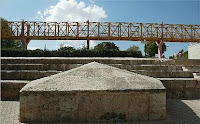Valencia is characterized by the large number of bridges along old Turia riverbed, some fifteen bridges, most of them of medieval root like the Trinity, Serranos and “Puente del Real”, others modern style such as the Gateway, Pasarela or Pont de Fusta, such others avantgardist From the architect Santiago Calatrava. The flowers Bridge is one of the best known.
This set of bridges is complemented by the defense of water system that would prevent flooding and is known as the parapets and its artistic environment.
This system is a colossal unit work for its size hardly comparable with other European river defenses.
Its main part is the
“old work” or obra Vella" started between the
bridges of Trinidad and El Real between 1591 and 1592 and from the
Real Bridge to the Sea. The parapets were done between 1606 and
1674. This parapets also contain some decorative works, concentrated
in the Paseo de la Pechina, with handrails, ramps, stairs and
stone work. Especially in the southern parapet near the Botanical
Gardens, one can find a wide ramp down to the river dated from 1765.
This is a railing of Stone-walk for loading and unloading to the
river, with horse-drawn carts or draft animals or beasts of burden.
The aforementioned ramp has some bumps in stone that can be
considered the ancestors of our speed bumps at the entrance of our
towns.

This kind of speed reducers permitted to the horse chars a safely to our Turia river bed. Then mule driver loaded the wood coming from the mountains, filled water pitchers or perform other functions. At the bottom of the bumped stone walk there is a great convex shape Shell. This famous sculpture gave name to the alley known by valencian people as Paseo de la Pechina.

If you drive your bike a little further up in the Turia River Park, at the height of the "Water House" you can consider a stone-bow into the walls, marking an ancient canal or water intake of this ditch, named acequia de Rovella.


The Canal of Rovella at his end beside the Music Palace (2012) and at 1946.

The beginning of Rovella Canal at 1950 and 2012
Plant and tree elements, both Mediterranean and American, give a new life today to the city renew river bed. The newly planted trees are particularly interesting to us such as jacaranda tree of Brazil and Peru and South American Bottle-tree.


This kind of speed reducers permitted to the horse chars a safely to our Turia river bed. Then mule driver loaded the wood coming from the mountains, filled water pitchers or perform other functions. At the bottom of the bumped stone walk there is a great convex shape Shell. This famous sculpture gave name to the alley known by valencian people as Paseo de la Pechina.

If you drive your bike a little further up in the Turia River Park, at the height of the "Water House" you can consider a stone-bow into the walls, marking an ancient canal or water intake of this ditch, named acequia de Rovella.


The Canal of Rovella at his end beside the Music Palace (2012) and at 1946.

The beginning of Rovella Canal at 1950 and 2012
Plant and tree elements, both Mediterranean and American, give a new life today to the city renew river bed. The newly planted trees are particularly interesting to us such as jacaranda tree of Brazil and Peru and South American Bottle-tree.

Ancient
Turia river bed new and refreshed gardens. A beautiful setting and a
unique scenery for its history and cultural values, as well as
a marvelous urban gardens that positions Valencia as special destiny
in Europe.
We ecologist would only
ask authorities to add soon to this this vegetation belt the ancient
Jesuit college garden connected with the Botanical Gardens.



No hay comentarios:
Publicar un comentario